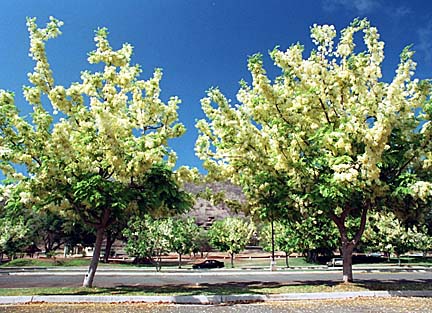

|
Kokua Line June Watanabe |
After purge, many
sites still not part
of state historic list
Question: I read Burl Burlingame's "Holoholo Honolulu" column every time it appears. Why are all the historic buildings he writes about on the National Register of Historic Places, but none are on the Hawaii Register of Historic Places? I should think Hawaii would be proud to have its historic buildings registered with the state.
|
Many others were once on the Hawaii Register, but were removed because of what came down to a failure to communicate.
In 1972, the Keeper of the National Register notified the states that all owners would have to be notified about nominations of their properties to local historic registers. That notification requirement became part of federal law in 1976.
The owner of the Kahaluu Fishpond subsequently challenged its listing on the Hawaii Register, arguing that he had never been notified.
The state Attorney General's Office then determined that the Hawaii Historic Places Review Board had failed to properly notify hundreds of owners of plans to place their properties on the register. Based on that, 579 sites, including state-owned property, throughout the state were removed from the Hawaii register in 1980.
Only 51 sites were able to remain on the register at that point
While the state had to remove hundreds of sites from its historic listing, federal officials said that, unless a site no longer met the criteria for being historic, it was grandfathered in to the National Register.
It's not simply a matter of pride to have something listed on either register, but sometimes, whether the owner wants it officially recognized as historic. While there's honor involved, there are also responsibility and restrictions, and many owners don't want to deal with that.
Foster Botanical Garden, the Kakaako Fire Station and Oahu Railway and Land Terminal are on both the national and Hawaii registers.
The other 47 are not on the Hawaii register, although many had been listed before 1980. They include Honolulu Hale, the Territorial Office Building, the Hawaii State Library, all on the National Register since 1978; Washington Place and St. Andrew's Cathedral, on the National Register since 1973; the Royal Brewery and Aliiolani Hale, on the National Register since 1972; the Mission Houses, on the National Register since 1966.
A total of 76 sites on Oahu were removed from the Hawaii register.
We looked to Thomas Lim, branch chief/architecture, with the state Department of Land and Natural Resources' Historic Preservation Division, to give us some background on the Hawaii register.
The state began to take a general inventory of its historic sites and structures and began processing nominees after the National Historic Preservation Act was passed in 1966, he explained.
The act authorized the National Register of Historic Places, which is kept by the National Park Service and which is the official list of the nation's cultural resources.
In Hawaii, the Historic Preservation Division is the "official keeper" of the Hawaii Register of Historic Places, which includes districts, sites, structures, buildings and objects that have some significance in Hawaii's history, architecture, archaeology, engineering and/or culture.
The problem is that, after the Hawaii Register was almost purged in 1980, there has not been enough time, resources or staff to try to get many back on the list, Lim said. There sometimes also is owner resistance.
While there are specific benefits, such as tax credits, to being on the historic register, Lim noted that there is also an obligation to maintain the buildings in a certain condition.
Among the criteria for being on the state register: a building or site has to be at least 50 years old; it is associated in some way with someone famous; it is part of the overall fabric of a district or community, such as being a part of the early settlement of Chinatown; its architecture, by itself, is significant or a famous architect designed it; or it is unique for some distinguishing reason, such as craftsmanship.
By having a Hawaii historic register, the state is able "to freeze some aspect of the past so people have a chance to make a connection," Lim said.
For questions about the Historic Register and the nomination process, call 692-8015.

|
Q: Is it my imagination or are we having shower trees blooming all summer long? In previous years, I seem to recall they bloomed April, May, June. Here it is the end of August and the town seems to be bursting with shower trees. More rain? Cooler Weather? I don't know. What is it? Or am I wrong?
A: You're not necessarily wrong, but there's nothing really unusual happening, according to experts at Foster Botanical Garden.
The season for shower trees is March to late October or late November, we were told. The peak blooming period is usually July or August.
So, you've still got a lot more days to enjoy the blooms.
|
Call 529-4773, fax 529-4750, or write to Kokua Line,
Honolulu Star-Bulletin, 500 Ala Moana Blvd., No. 7-210,
Honolulu 96813. As many as possible will be answered.
E-mail to kokualine@starbulletin.com
